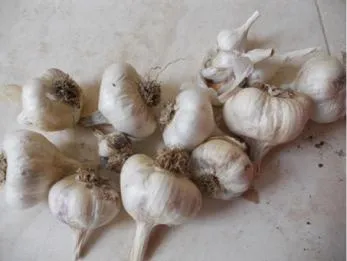Scientific Name
Allium sativum
General Information

Garlic is a vegetable food crop with a bulb, stem, and leaves. All parts of the plant are edible, and young plants are sometimes harvested for flavor and nutrition. At maturity, leaves are dry and the bulb is the prize. Native to Middle Asia, although different Allium varieties are found all over the world.
When to Plant
Plant garlic between October 15 and February 15, although garlic planted in the fall tend to be larger.
Planting
Start with garlic bulbs purchased from a nursery rather than a grocery store. Plant individual cloves (do not peel off papery skin) from certified disease-free bulbs in beds that get sun during the winter. The larger cloves on the outside of the bulb will produce the largest bulbs. Plant pointy-end up, one inch down, and four inches apart in rows 12-18 inches wide. Don’t water the day you plant.
Soil Requirements
Plant in well-draining, rich soil. Add mulch once the garlic tops have poked through, likely in December (if planted in November.)
Water Requirements
After planting in Oct/Nov, wait to water. Let the fall/winter rains do all the work for you until irrigation is needed in the spring. Keep moisture levels consistent, but never soggy. Too much water can rot garlic bulbs.
Fertilizing
At planting, add compost and a fertilizer with more potassium and phosphorus than nitrogen to enrich the soil. Garlic will be in the ground for about six months and benefits from a good start. In the spring, fertilize with an organic balanced mixture to promote overall growth.
Pollination
Blooms are usually cut off of flowering hardneck garlic (see below). Softneck garlic does not produce a flower.
Harvesting
Cut water by half in May to begin preparing your plants for harvest. In late June or July, after the lower half of the plant’s leaves are brown and dry, trowel gently under the bulb, shaking off excess soil while pulling the stem. Pulling on the stem alone can damage the plant. Brush off the soil and enjoy!
Storage
Cure your plants by putting the entire plant in a warm, dry place out of direct sunlight for three to six weeks. When dried (cured), clean bulb by brushing off one to two layers of loose, broken skin, cut roots to one-half inch, and braid or cut stems two inches from the bulb. Store garlic in a paper or mesh bag out of the sun in a cool, dry, airy place for several months. (Do not refrigerate.)
Good Varieties for Marin
There are two types of garlic: softneck (Allium sativum) and hardneck (Allium ophioscorodon).
Softneck garlic is best adapted to Marin County. It is characterized by a ring of cloves surrounding a smaller ring of cloves. Softneck garlic stores well and the tops are good for braiding.
Softneck varieties include:
- 'California Early'
- 'California Late'
- 'Silverskin'
- 'Inchelium Red'
- 'Early Italian Purple'
Hardneck garlic has one ring of cloves surrounding a center stem, or scape. Hardneck does better in cooler areas. It is generally recommended that the center scape (flower) be cut off before it blooms so more energy is directed to the bulb. Scapes can be eaten.
Hardneck varieties include:
- 'Chesnok Red'
- 'Music'
- 'Spanish Roja'
- 'German Red'
- 'Asian Tempest'
- 'China Stripe'
- 'Italian Red Rocambole'
- 'Siberian'
Helpful Tips
Be sure not to overwater garlic bulbs when they are close to harvest. A mature bulb may split or rot with too much moisture. When curing, be sure to dry garlic completely before storing. If there were no problems with your garlic harvest, keep aside the largest cloves, while enjoying the smaller ones. These “seed” cloves can be planted next fall.
Common Problems
Overwatering.
Pests- Diseases & More
For black aphids, wash with a steady stream of water. Other issues include white rot, nematodes, thrips, or downy mildew.

